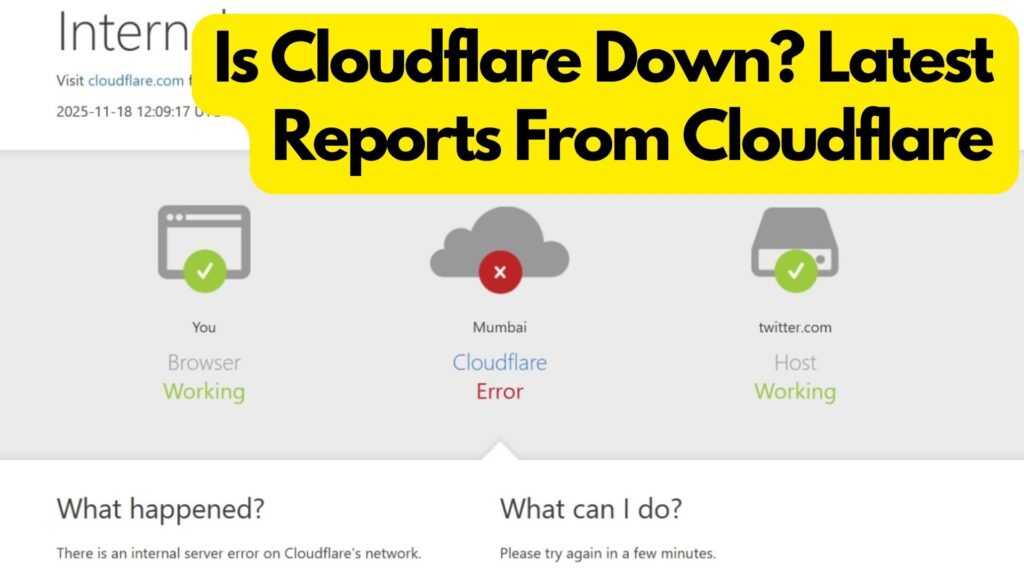Sensorstechforum.com Newsroom – November 18, 2025. A major outage at internet infrastructure provider Cloudflare today briefly broke large parts of the web, knocking services such as X (formerly Twitter), OpenAI’s ChatGPT, Canva and multiple other platforms offline or making them extremely slow for users worldwide. Reports of problems surged on outage-tracking site Downdetector as frustrated users turned to Reddit and other channels to confirm that the issue was not on their side.
Cloudflare, which sits between websites and their users as both a security layer and a content delivery network, confirmed “internal service degradation” on its status page and later said it had identified the root cause and implemented a fix. However, some services continued to experience elevated error rates for hours as systems recovered.
Timeline of the Cloudflare Outage
According to Cloudflare’s public status updates and multiple media reports, the incident began in the morning of November 18, 2025, when the company observed a spike in “unusual traffic” across parts of its global network. That surge triggered widespread HTTP 500 errors for traffic passing through Cloudflare’s infrastructure.
- Shortly after the disruption began, thousands of users reported issues accessing X, ChatGPT and other popular services via Downdetector.
- Cloudflare acknowledged “internal service degradation” on its system status page and said engineers were investigating.
- As the incident evolved, the company temporarily disabled certain services, including its WARP secure DNS and Access products in specific regions, to stabilize the network.
- By late morning UTC, Cloudflare reported that a fix had been deployed and that services were beginning to recover, though some customers still saw elevated error rates.
In a subsequent explanation, Cloudflare said the outage was linked to an oversized, automatically generated configuration file used to manage threat traffic which caused a software component to crash. The company emphasized there was no indication of a cyberattack, but acknowledged the seriousness of the failure and promised a detailed post-incident report on its blog.
Which Services Were Affected?
The incident highlighted just how many services depend on Cloudflare for protection and performance. Outage trackers and independent reporting indicate that a broad mix of consumer, enterprise, and public-sector services were impacted.
- Social media and communications: X (formerly Twitter), various messaging and content platforms experienced partial or total outages.
- AI and cloud services: OpenAI’s ChatGPT and related tools, as well as other AI-powered services relying on Cloudflare’s network, reported degraded performance or downtime.
- Web tools and productivity: Online design platform Canva and other SaaS tools saw spikes in user error reports.
- E-commerce and financial services: Several online shops and payment-related services using Cloudflare as a reverse proxy or CDN briefly returned internal server errors to customers.
- News and information sites: Multiple media outlets and government-related websites using Cloudflare for DDoS protection and caching also displayed error pages during the peak of the incident.
At one point, even Downdetector itself—which relies on Cloudflare—struggled to load for some users, adding an ironic twist as people tried to confirm that the internet’s watchdog was also down.
User Reactions: “Is It Just Me?”
As usual during large-scale outages, social media and community forums became the first place users looked for answers. On Reddit and X, users described being suddenly unable to load X, or stuck in Cloudflare’s bot-detection challenge while simply trying to visit routine sites or even check the status of the issue on Downdetector.
One user described being unable to get past a robot check on a Cloudflare-protected site, while another noted that X “just wouldn’t load at all” in their region, attributing the disruption to a Cloudflare failure. As more reports appeared from multiple countries, it quickly became clear that the problem was not isolated to a single ISP or geography.
What Is Cloudflare and Why Does It Matter?
Cloudflare is one of the world’s largest content delivery networks and security providers. It sits in front of websites as a sort of shield and traffic manager, handling everything from caching and load balancing to DDoS mitigation and bot detection. According to public figures, a significant portion of the world’s websites rely on Cloudflare in some way.
- CDN (Content Delivery Network): Cloudflare caches copies of websites across a global network of data centers to serve content faster and reduce load on origin servers.
- Security services: The company provides protection from DDoS attacks, malicious bots, comment spam, and other forms of abusive traffic.
- Zero Trust and access control: Products such as Cloudflare Access and WARP help organizations secure internal apps and enforce identity-based access policies.
- DNS and performance: Cloudflare also runs popular DNS services and optimization tools that influence how quickly websites resolve and load worldwide.
When that central layer experiences issues—as it did today—the impact cascades down to every website and app using it, even if those sites’ own servers are operating normally. That is why users saw “Internal server error” pages listing Cloudflare error codes, even though the underlying web application itself had not necessarily failed.
Readers can find more background on the company’s role in the internet ecosystem on the Cloudflare website at cloudflare.com and in public reference sources such as Wikipedia’s Cloudflare entry.
How Downdetector Tracks Outages
Downdetector is a well-known platform where users can report problems with online services in real time. Rather than relying on official statements, the site aggregates user-submitted issues and signals an outage when reports exceed normal background levels for a given period.
- User reports: Visitors submit what kind of problem they are experiencing, such as login failures, timeouts or complete inaccessibility.
- Pattern analysis: The platform looks for spikes in complaints that are significantly higher than the usual volume for that service at that time.
- Additional signals: Downdetector also ingests indicators from social media and other online sources to refine its view of an incident.
- Visualization: Outage maps and timelines give a visual representation of where and when users are affected.
The service describes itself as “where people go when services don’t work” and has become a routine reference point for both users and journalists during major disruptions.
What Caused Today’s Cloudflare Outage?
Initial statements from Cloudflare indicate that today’s outage was not the result of a cyberattack, but of an internal software failure triggered by configuration data. The company said that an automatically generated configuration file used to manage threat and security rules grew beyond expected limits, causing a key component of its traffic-handling software to crash.
The sequence of events, based on public reports and Cloudflare’s own messaging, appears to be:
- A surge of unusual traffic hit one of Cloudflare’s services, stressing systems responsible for inspecting and filtering requests.
- The configuration file managing this traffic exceeded its anticipated size, triggering a software crash across parts of the platform.
- This failure cascaded into widespread HTTP 500 errors, affecting multiple Cloudflare services and the websites behind them.
- Engineers deployed configuration and software changes to restore functionality, though it took several hours for all affected services to normalize.
Cloudflare has apologized to customers and pledged a full post-mortem, which is expected to be published on the company’s official blog at blog.cloudflare.com. For organizations relying on the company’s infrastructure, that technical analysis will be central to understanding how similar incidents might be prevented in the future.
Why These Outages Keep Happening
Today’s incident follows other recent, high-profile outages at major cloud and infrastructure providers. In the past months, issues at Amazon Web Services and Microsoft Azure have also knocked popular apps and websites offline, raising concerns about the internet’s dependence on a small number of central providers.
- Concentration of traffic: When a single provider handles a large share of global web traffic, any internal problem can quickly scale into a widespread outage.
- Complex systems: Modern cloud and security platforms are deeply complex, with thousands of moving parts; small configuration issues can have large, unexpected effects.
- Third-party dependencies: Providers themselves depend on other vendors (such as support portals and monitoring tools), creating layered risk.
For end users, these incidents are often experienced simply as “the internet is down,” even though the root cause traces back to specific infrastructure layers that most people never see.
What Organizations Can Do Now
While no organization can fully insulate itself from a failure at a global provider, today’s outage offers security and IT teams an opportunity to reassess their resilience strategies.
- Review single points of failure: Identify where your applications rely on one CDN, DNS provider or security gateway, and consider multi-vendor or failover options where feasible.
- Test incident playbooks: Ensure your teams know how to respond when a third-party provider experiences issues, including communication plans for customers.
- Monitor independently: Use external monitoring, in addition to provider status pages, to validate whether your services are truly reachable from different regions.
- Harden user communication: Prepare status pages and messaging templates so that users receive clear, timely information during outages.
For now, Cloudflare says its network has largely recovered and most services are back online. But for thousands of users who woke up to broken apps and error pages, today’s outage is another reminder of how dependent our digital lives have become on a handful of critical, and sometimes fragile, infrastructure providers.
Sensorstechforum.com will continue to follow Cloudflare’s post-incident analysis and update this story as new technical details emerge.



